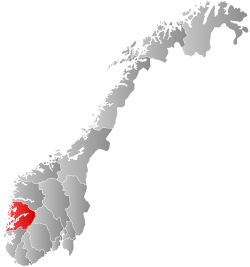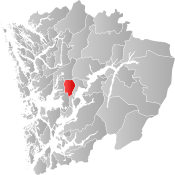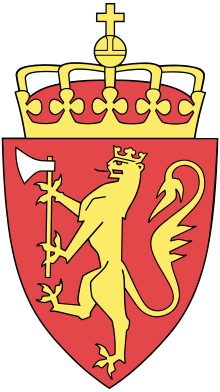Hålandsdal
Hålandsdal is a former municipality in the old Hordaland county, Norway. The 131-square-kilometre (51 sq mi) municipality existed from 1903 until 1964. It encompassed the eastern part of what is now Bjørnafjorden Municipality in Vestland county. It included the large lakes Skogseidvatnet and Gjønavatnet and all of their surrounding valleys. The administrative centre of the municipality was the village of Holdhus where the Holdhus Church is located.[1]
Hålandsdal herad Haalandsdal herad | |
|---|---|
 Hordaland within Norway | |
 Hålandsdal within Hordaland | |
| Coordinates: 60°14′N 05°49′E | |
| Country | Norway |
| County | Hordaland |
| District | Midhordland |
| Established | 1 Jan 1903 |
| Disestablished | 1 Jan 1964 |
| Administrative centre | Holdhus |
| Area | |
| • Total | 131 km2 (51 sq mi) |
| *Area at municipal dissolution. | |
| Population (1963) | |
| • Total | 534 |
| • Density | 4.1/km2 (11/sq mi) |
| Time zone | UTC+01:00 (CET) |
| • Summer (DST) | UTC+02:00 (CEST) |
| ISO 3166 code | NO-1239 |
| Preceded by | Fusa in 1903 |
| Succeeded by | Fusa in 1964 |
History
On 1 January 1903, the parish of Hålandsdal (historically spelled Haalandsdal) was separated from the municipality of Fusa to form a separate municipality of its own. Initially, Hålandsdal had a population of 647. It was a small municipality and so in the early 1960s, the Schei Committee recommended that it be merged with two of its neighbors: Fusa and Strandvik. So, on 1 January 1964, Hålandsdal was merged with Strandvik and most of Fusa, creating a new, larger municipality of Fusa. Prior to the merger, Hålandsdal had a population of 528.[2]
Government
Municipal council
The municipal council (Heradsstyre) of Hålandsdal was made up of 13 representatives that were elected to four year terms. The party breakdown of the final municipal council was as follows:
| Party Name (in Nynorsk) | Number of representatives | |
|---|---|---|
| Local List(s) (Lokale lister) | 13 | |
| Total number of members: | 13 | |
| Party Name (in Nynorsk) | Number of representatives | |
|---|---|---|
| Local List(s) (Lokale lister) | 13 | |
| Total number of members: | 13 | |
| Party Name (in Nynorsk) | Number of representatives | |
|---|---|---|
| Local List(s) (Lokale lister) | 12 | |
| Total number of members: | 12 | |
| Party Name (in Nynorsk) | Number of representatives | |
|---|---|---|
| Local List(s) (Lokale lister) | 12 | |
| Total number of members: | 12 | |
| Party Name (in Nynorsk) | Number of representatives | |
|---|---|---|
| Local List(s) (Lokale lister) | 12 | |
| Total number of members: | 12 | |
| Party Name (in Nynorsk) | Number of representatives | |
|---|---|---|
| Labour Party (Arbeidarpartiet) | 5 | |
| Local List(s) (Lokale lister) | 7 | |
| Total number of members: | 12 | |
References
- Store norske leksikon. "Hålandsdal" (in Norwegian). Retrieved 2014-07-14.
- Jukvam, Dag (1999). "Historisk oversikt over endringer i kommune- og fylkesinndelingen" (PDF) (in Norwegian). Statistisk sentralbyrå.
- "Kommunevalgene og Ordførervalgene 1959" (PDF) (in Norwegian). Oslo: Statistisk sentralbyrå. 1960. Retrieved 2020-02-16.
- "Kommunevalgene og Ordførervalgene 1955" (PDF) (in Norwegian). Oslo: Statistisk sentralbyrå. 1957. Retrieved 2020-02-16.
- "Kommunevalgene og Ordførervalgene 1951" (PDF) (in Norwegian). Oslo: Statistisk sentralbyrå. 1952. Retrieved 2020-02-16.
- "Kommunevalgene og Ordførervalgene 1947" (PDF) (in Norwegian). Oslo: Statistisk sentralbyrå. 1948. Retrieved 2020-02-16.
- "Kommunevalgene og Ordførervalgene 1945" (PDF) (in Norwegian). Oslo: Statistisk sentralbyrå. 1947. Retrieved 2020-02-16.
- "Kommunevalgene og Ordførervalgene 1937" (PDF) (in Norwegian). Oslo: Statistisk sentralbyrå. 1938. Retrieved 2020-05-16.

